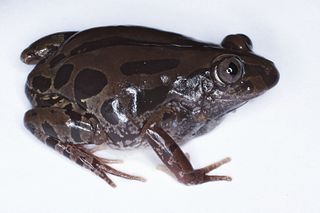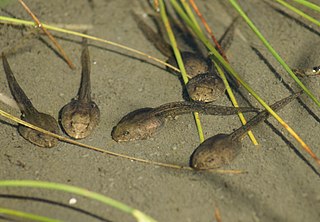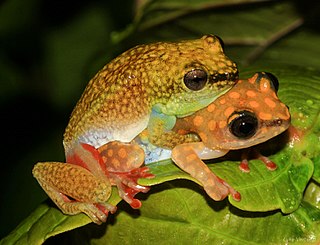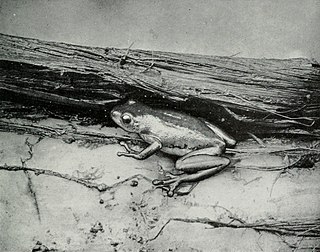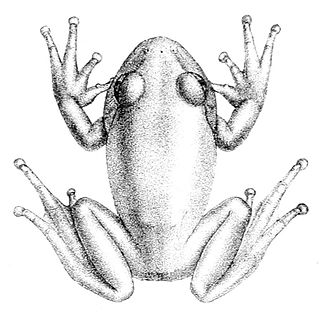| Kassina cassinoides | |
|---|---|
| Scientific classification | |
| Kingdom: | Animalia |
| Phylum: | Chordata |
| Class: | Amphibia |
| Order: | Anura |
| Family: | Hyperoliidae |
| Genus: | Kassina |
| Species: | K. cassinoides |
| Binomial name | |
| Kassina cassinoides (Boulenger, 1903) | |
| Synonyms [2] | |
Hylambates cassinoidesBoulenger, 1903 | |
Kassina cassinoides, also known as large running frog or silver running frog, is a species of frog in the family Hyperoliidae. [1] [2] [3] [4] It is found in Cameroon and—disjunctly—in West Africa, specifically in (from west to east) in Senegal, the Gambia, Mali, Burkina Faso, Ivory Coast, Ghana, Togo, and Benin. [1] [2] It might occur more broadly, and presumably occurs in Guinea, Guinea-Bissau, Niger, Nigeria, [1] and Mauritania. [2]
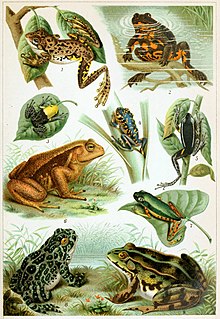
A frog is any member of a diverse and largely carnivorous group of short-bodied, tailless amphibians composing the order Anura. The oldest fossil "proto-frog" appeared in the early Triassic of Madagascar, but molecular clock dating suggests their origins may extend further back to the Permian, 265 million years ago. Frogs are widely distributed, ranging from the tropics to subarctic regions, but the greatest concentration of species diversity is in tropical rainforests. There are over 7,000 recorded species, accounting for over 85% of extant amphibian species. They are also one of the five most diverse vertebrate orders. Warty frog species tend to be called toads, but the distinction between frogs and toads is informal, not from taxonomy or evolutionary history.

The Hyperoliidae, sedge and bush frogs, are a large family of small to medium-sized, brightly colored frogs which contains more than 250 species in 19 genera. Seventeen genera are native to sub-Saharan Africa. In addition, the monotypic genus Tachycnemis occurs on the Seychelles Islands, and the genus Heterixalus is endemic to Madagascar.

Cameroon, officially the Republic of Cameroon, is a country in Central Africa. It is bordered by Nigeria to the west and north; Chad to the northeast; the Central African Republic to the east; and Equatorial Guinea, Gabon and the Republic of the Congo to the south. Cameroon's coastline lies on the Bight of Biafra, part of the Gulf of Guinea and the Atlantic Ocean. Although Cameroon is not an ECOWAS member state, it is geographically and historically in West Africa with the Southern Cameroons which now form her Northwest and Southwest Regions having a strong West African history. The country is sometimes identified as West African and other times as Central African due to its strategic position at the crossroads between West and Central Africa.

